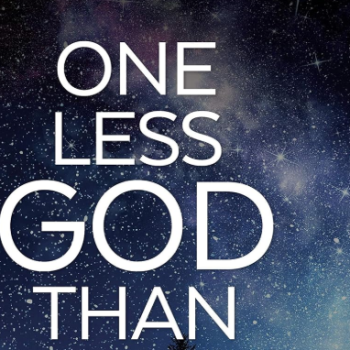
Guest writer: Zizzer Zazzer Zuzz
How’s it hanging?
[This post is a continuation from/reply to Pilgrim’s post on the Shroud of Turin. Rather than picking back up there, I’ve asked Dennis to post this to start fresh. Most of what I have here was written not too long after his post, I just hadn’t quite wrapped up (pun not intended) and I let things slip. I did want to address the physical image itself, and most importantly, the WAXS paper. Note that some of what I address is from the comments of the previous post.]The Image
Finally, the biggest problem of all. What does the shroud have the appearance of? It has been described as either a painting or a photograph. What do these have in common? They are the projection of a three-dimensional body onto a two dimensional plane. The question is how does one “perfectly” transfer the 3D representation of a human body onto a flat sheet…while that sheet is wrapped around the body? There is no distortion, no gaps in the image where folds or creases in the cloth would not have had a direct path to the body. Think of a globe vs. a map. You can look at a globe and see, say, North America. You may be looking directly at the central US and on the edges, Alaska, Greenland, and South America are curving away. Now look at a map, the most common projection being the Mercator projection. Looks nice on a classroom wall, but heavily distorts the edges. Everything is flat, oriented in a single direction while we know, they point in different directions. Look at Greenland, it appears to be roughly the size of Africa, when it is maybe 1/15th the size.
After I had written much of this, Pilgrim had then posted a few links on the shroud being draped rather than wrapped. This would require laying a sheet flat, placing the body on it, then folding the rest of the sheet over the body. As far as I can tell, this is in no way consistent with any known Jewish burial practice. Looking at the links, one of the papers shows what an image of a face looks like when a cloth is draped over it and claims there is minimal distortion. The problem is that they never show what the image looks like when they lay the cloth flat. We can fix that, however. We can take the image and overlay a rectangular grid, then stretch out the image so the existing (draped) gridlines match up. The result is the same as laying the cloth flat.


Comparison of facial image on draped cloth and as it would be seen laid flat.
I will admit I was a little surprised that the image wasn’t nearly as distorted as I thought it would be, but you can easily tell that it isn’t quite right. I also imagine they took care to ensure the sheet was as flat as they could get it. The top of the head is noticeably pointy, the forehead/hairline is oddly shaped, and the center of the face appears squished in as if everything is being pulled into the nose. Granted, I didn’t get the grid perfectly aligned (most of the remaining distortion is outside the face anyway) and the image quality/resolution isn’t the best, but the face is noticeably distorted. Would we be able to tell the difference if we didn’t have the original to compare? I don’t know, but I think most people might say something was off.
How Was Jesus Buried?
Now, how is the burial of Jesus described in the bible? He was wrapped in a linen shroud. When the disciples went into Jesus’ tomb, it is said they found the separate head cloth neatly folded in the corner while the strips of linen cloth were laying off to the side. As another example, Lazarus had his hands and feet bound in linen strips and had a cloth wrapped around his head. So what was the shroud? Was it the cloth (cloths? strips?) that were wrapped around the body? That obviously couldn’t be because the cloth would have had to have been nearly planar (or draped) in order not to be distorted, and the shroud is obviously a single piece of cloth, not multiple strips. Was it a separate cloth? Certainly possible, but that separate cloth couldn’t have been wrapped around the body as described as that would lead to distortion. Additionally, there would have been layers of wrapped cloth in between, which would have interfered with not only with the transfer of blood, but the transfer of the image itself. There is nothing in the Bible (or known Jewish burial practices that I could find) to indicate a separate sheet would have been folded and draped over a wrapped body.
Following the draping claim, Pilgrim makes the next assertion that there is “research” that indicates the body was not flat, but in an upright position when the image was formed. Now we’ve gone from the shroud being draped over a prone body (with half of the shroud underneath, half on top) to the body being upright. So how is the sheet now draped over an upright body while remaining “flat?” Looking at the actual shroud itself, we see a gap between the image of the front and the back of the head. If the sheet was draped over an upright body, the sheet would be in contact with the entire head (think Charlie Brown’s Halloween costume) and the image would be continuous here. The sheet wouldn’t be falling away from the face toward the back of the head, it would be falling down towards the feet.
The Burial Process
Another aspect of the burial to consider is the process itself. The body was taken down, then according to tradition, would have been washed, anointed with oil/spices, then wrapped. Was the body washed? I don’t think the bible says explicitly one way or another. If it was, there wouldn’t be any blood rivulets since the body would no longer be bleeding and anything oozing out would be absorbed by the cloth and wouldn’t run. Additionally, forensic studies have shown that the blood on various portions of the body could not have formed from a single position, patterns in a single location could have only formed if the body was in two different positions simultaneously. So, what if the body wasn’t washed? Based on the descriptions of the various wounds, there should have been much more blood.
Back to the radiation theory. Is the shroud like a canvas or a film negative where the image was projected onto the cloth? Again, it would have either have been wrapped around or contoured to the body, which means obvious distortion of the image, or it somehow would have been flat/draped, which means no body contact, which means no blood stains. Even if it were flat, why would the radiation travel from the body exclusively in a single direction? That’s not how radiation works.
Now again, what does the shroud look like? A non-distorted image where rivulets (not drops) of blood, which would have been on the flesh, were pressed into the cloth. To have all the blood stains, the cloth would have had been pressed against the body. For the image to not be distorted, the cloth would have had to have been flat, almost exactly perpendicular to the body. These two scenarios are mutually exclusive. If we want a non-distorted image, we have to resort to a single draped cloth, while the Bible is pretty clear that there were multiple pieces wrapped on the body, so that draped cloth must have been outside the wrapped cloths, again no blood stains. We’ve also added in the mutually exclusive draped shroud while the body is upright. I’ve mentioned researchers stating that how the blood runs down different parts of the body indicates the body would have had to have been in different orientations simultaneously. In short, to produce this image of a body by physical transfer is impossible since it would require multiple mutually exclusive conditions simultaneously.
Finally, in two of Pilgrim’s later comments, he states
No doubt there will be future experiments to confirm or deny sources that do conform to the laws of physics – but if there was a supernatural force ……? [emphasis mine – ZZZ]
and
But we’re talking about the resurrection …
If it was supernatural, why even bother trying to come up with a natural explanation at all? I’m going to go ahead and claim that the Shroud is not Jesus’ burial cloth, but in fact his very first onesie. Prove me wrong.
WAXS on, WAXS off
So, the WAXS paper. From a bit of searching, I see some people commenting that the theory may be technically sound, but the actual technique itself is not yet proven or even reliably explored. Carbon dating (agree with the relevant test results or not) is a very simple, well-established test that is only dependent on the relative amounts of carbon isotopes. The WAXS test relies on a lot more assumptions, many of which appear to be environmental, and the technique for this purpose has not been tested or verified anywhere else.
[As an aside, in grad school, my PhD included a minor in materials science. I took a couple of classes in X-ray diffraction and crystallography. My first real job (before that degree) involved measuring and quantifying degradation rates of explosives due to aging for the Navy (similar concepts to aging of fibers). I have a couple papers published in reputable materials science journals (nothing ground breaking or even really interesting). I will readily and willingly admit I’m not an expert at all and don’t even remember much of what I learned, but I’ll say my view on this paper is maybe a bit more than just a random opinion off of the street.]One of the very first things that jumps out in the abstract is
The experimental results are compatible with the hypothesis that the TS is a 2000-year-old relic, as supposed by Christian tradition, under the condition that it was kept at suitable levels of average secular temperature—20.0–22.5 °C [68-72.5 °F]—and correlated relative humidity—75–55%—for 13 centuries of unknown history,
That is a HUGE assumption right there. They don’t know what the storage conditions were for 13 centuries but claim that if they were in some fairly narrow range, it would fit what they were looking for. To repeat, they make the assumption that the shroud must have been stored at a very comfortable and consistent room temperature, much of it quite possibly in the Middle East, for over a thousand years in order for it to fit their test results. That’s not science, that’s making your experiment fit the results you’re looking for.
I did a bit of searching on the technique itself, and there isn’t much out there. Some of what is written talks about how the determination of how fibers age isn’t very robust or well researched. I did find one discussion that did give some insight and it summarized some things well.
From that:
If mechanical deterioration could really be used as a chronograph, then surely it would have been taken up by now, but a glance at Google Scholar tells us that ‘Multi-parametric micro-mechanical dating of single fibers coming from ancient flax textiles’ [a related paper-ZZZ] has only been cited 11 times since publication in 2014, 7 times by Fanti himself, and all of them solely in connection with the Shroud. The archaeological world, it seems, remains unimpressed. We’ll have to wait to see if this crystallographic idea meets with better success.
A few other discussions I’ve found point out that if they really wanted to establish this technique as accurate, they would have first used and measured multiple different fabrics whose ages are well known, then moved onto the shroud.
Another concern, as Pilgrim wrote
Some have agendas – both atheist and Christian.
Again, from the link:
Although the authors declare no conflict of interest, which may in its commonly recognised financial sense be true, at least two are deeply personally convinced of the authenticity of the Shroud…Furthermore, Giulio Fanti is convinced the Shroud is authentic based on a personal revelation in 1998…The claim that the authors have no conflict of interest, when they are actually avowedly committed to the authenticity of the Shroud, is dishonest.
My very first post on the topic here was to ask Pilgrim about the paper he claims was retracted by the journal (no such paper is currently found) while linking to a paper I found that actually was retracted. Ironically that retracted paper was written by some of the same authors as the WAXS paper and was retracted because
Concerns have been raised that the data presented in this article are not sufficient to support the conclusions drawn; the provenance, integrity and availability of the material used for the study have also been questioned.
So, in summary: a single paper, written by a group with obvious bias who have already had a related paper retracted for dubious rigor, using a test whose reliability has not really been established, making an incredible assumption on the conditions of the material being tested, has somehow “proven” that the Shroud is actually 2000 years old. Searching for the shroud and WAXS, almost all the results are either Christian publications or simple reprints of the original paper with little or no commentary. I can find no other discussion on the results, either for or against. No discussion on other uses or verification of the technique. Looking at Heritage, the journal where the article was published, we see that it is an “international, peer-reviewed, open access journal of cultural and natural heritage science published monthly by MDPI” where the reviewers receive vouchers for discounts on their next publications. I’m sure the review process is top-notch, but why would they not publish such groundbreaking research in a relevant journal, something related to crystallography, spectrograph, physics, chemistry, etc.?
Honestly, this article is a joke. Poorly researched, highly questionable results, obvious bias, submitted to an unrelated journal quite possibly lacking academic rigor. I don’t see how anyone could read this and take it seriously. Could their results be accurate? Maybe, but I wouldn’t place any bets. Christian science at its finest.
Thank you!
If you liked this article, please leave your comments below. I am very interested in your opinion on this topic.
Read The Latin Right’s other writing here.
Please visit my Facebook page and IM your questions (and follow my page) or topics for articles you would like covered.
Also, please subscribe my YouTube page for updates on upcoming articles.

















